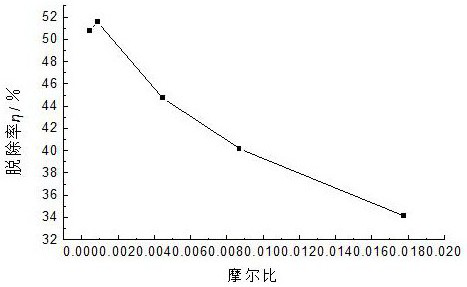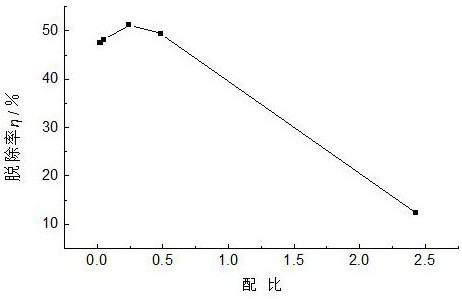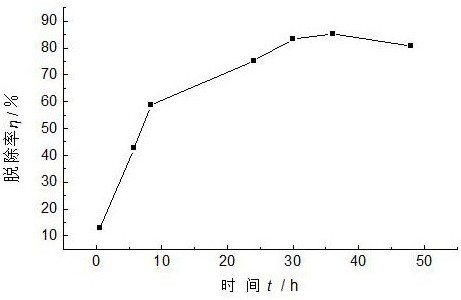Coke-supported CE-doped biocl catalytic method for removing bisphenol-A
A coke and removal technology, which is applied in the direction of chemical instruments and methods, physical/chemical process catalysts, chemical/physical processes, etc., can solve the problems such as the ineffective oxidation and removal of bisphenol A, achieve outstanding photocatalytic activity, improve The effect of removal rate and removal rate improvement
- Summary
- Abstract
- Description
- Claims
- Application Information
AI Technical Summary
Problems solved by technology
Method used
Image
Examples
Embodiment 1
[0030] 1) Coke pretreatment: Crush large pieces of coke and select coke with a particle size of 5-7 mm; wash with distilled water several times until the upper liquid has no black floating powder; dry in a far-infrared rapid constant temperature drying oven at 403 K for 2 h to constant weight.
[0031] 2) Modification of coke
[0032] Weigh an appropriate amount of pretreated coke into a beaker, soak it in 20% NaOH for 36 h (the liquid level is above the coke, seal it, and store it in the dark at room temperature); after 36 h, wash it with ultrasonic water. Firstly, the alkali-soaked coke was ultrasonically washed twice with a solution of water and ethanol with a volume ratio of 1:1, and then washed with deionized water for 5-6 times (stirring while washing with water during the ultrasonic washing process), and the washing time for each time was 7 min until the upper liquid is not cloudy. After ultrasonic washing, the coke was dried in a far-infrared rapid constant temperatu...
Embodiment 2
[0039] 1) Pretreatment of coke: crush large pieces of coke and select coke with a particle size of 5-7 mm; use distilled water to wash several times until the upper liquid has no black floating powder; Heavy.
[0040] 2) Modification of coke
[0041]Weigh an appropriate amount of pretreated coke into a beaker, soak it in 20% NaOH for 30 h (the liquid level is above the coke, seal it, and store it in the dark at room temperature); after 30 h, wash it with ultrasonic water. First, the alkali-soaked coke was ultrasonically washed 3 times with a solution of water and ethanol with a volume ratio of 1:1, and then washed 5-6 times with deionized water (stirring while washing with water during the ultrasonic washing process), and the cleaning time for each time was 7 min until the upper liquid is not cloudy. After ultrasonic washing, the coke was dried in a far-infrared rapid constant temperature drying oven at 400 K for 2 h to obtain alkali-modified coke.
[0042] 3) Preparation o...
Embodiment 3
[0048] 1) Pretreatment of coke: crush large pieces of coke and select coke with a particle size of 5-7 mm; use distilled water to wash several times until the upper liquid has no black floating powder; Heavy.
[0049] 2) Modification of coke
[0050] Weigh an appropriate amount of pretreated coke into a beaker, soak it in 20% NaOH prepared for 40 h (the liquid level is above the coke, seal it, and store it in the dark at room temperature); after 40 h, wash it with ultrasonic water. First, the alkali-soaked coke was ultrasonically washed 3 times with a solution of water and ethanol with a volume ratio of 1:1, and then washed 5-6 times with deionized water (stirring while washing with water during the ultrasonic washing process), and the cleaning time for each time was 7 min until the upper liquid is not cloudy. After ultrasonic washing, the coke was dried in a far-infrared rapid constant temperature drying oven at 400 K for 2 h to obtain alkali-modified coke.
[0051] 3) Pre...
PUM
| Property | Measurement | Unit |
|---|---|---|
| particle diameter | aaaaa | aaaaa |
Abstract
Description
Claims
Application Information
 Login to View More
Login to View More - R&D
- Intellectual Property
- Life Sciences
- Materials
- Tech Scout
- Unparalleled Data Quality
- Higher Quality Content
- 60% Fewer Hallucinations
Browse by: Latest US Patents, China's latest patents, Technical Efficacy Thesaurus, Application Domain, Technology Topic, Popular Technical Reports.
© 2025 PatSnap. All rights reserved.Legal|Privacy policy|Modern Slavery Act Transparency Statement|Sitemap|About US| Contact US: help@patsnap.com



